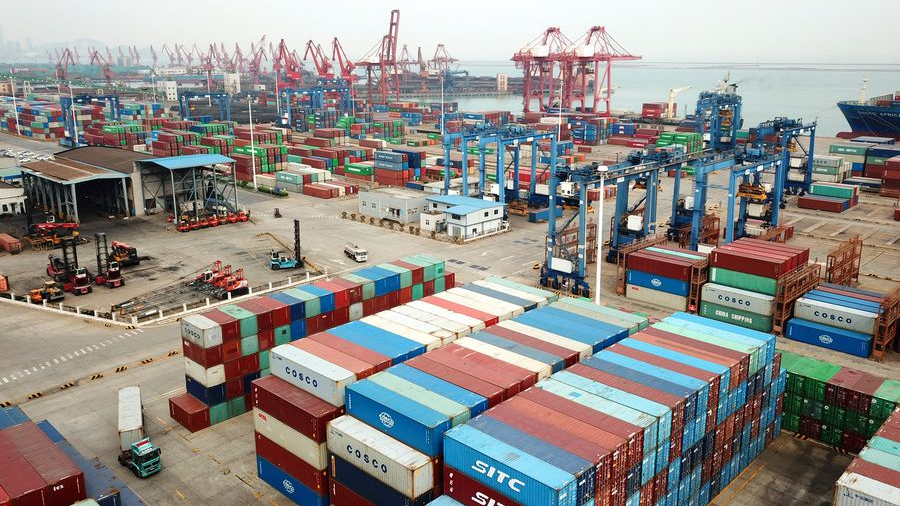
Containers at Lianyungang City, east China's Jiangsu Province, April 14, 2020. /Xinhua
Containers at Lianyungang City, east China's Jiangsu Province, April 14, 2020. /Xinhua
Editor's Note: Chen Jiahe is the chief investment officer at Novem Arcae Technologies. The article reflects the author's opinions, and not necessarily the views of CGTN.
Generally speaking, China's economy has three major drivers: Fixed asset investment, domestic consumption and international trade. While the importance of domestic consumption has been increasing in recent years, international trade is also very significant.
During the most grievous period of fighting against COVID-19 in the first quarter of 2020, China's international trade was hurt the most among the three factors. Later on in April and May, although the domestic economy quickly rebounded thanks to the containment of the epidemic, international trade was still under pressure since the pandemic was spreading in many trading partners of China.
However, the latest data from June shows a much better situation. Let's have a detailed look.
China's total amount of imports and exports, measured by the U.S. dollar, increased by 1.5 percent in June compared with one year ago. This data is much better than the figure of -9.3 percent in May and -5.1 percent in April and much better than the lowest record of -10.9 percent that was reported in February, when the country was doing everything possible to combat the unprecedented epidemic caused by a kind of virus that had never before been discovered.
The recovery of China's many trading partners from the COVID-19 pandemic is the major reason behind the picking up of China's international trade in June, since the situation was already under control in China by the end of March.
While the United States is an exception from the safe list, countries such as the United Kingdom, Germany, Japan, South Korea and many ASEAN members now have their COVID-19 situation well under control. Therefore, trading between China and these countries is now gradually coming back to normal.

ASEAN leaders attend the opening session of the 31st ASEAN Summit in Manila, Philippines, November 13, 2017. /Reuters
ASEAN leaders attend the opening session of the 31st ASEAN Summit in Manila, Philippines, November 13, 2017. /Reuters
A detailed look into China's trade with the major trading partners can reveal the relationship between the containing of the pandemic in one economic region and its trading with China. As COVID-19 is still spreading in the United States, and also partly because of the ongoing trading war between U.S. and China, the trade between the world's two largest economies in the first six months of 2020 decreased by 9.7 percent compared with the same period in 2019.
Meanwhile, despite the recent slight rebound, as Japan has been able to contain the domestic epidemic situation much better compared to the U.S., the trade between China and Japan has reduced by merely 2.9 percent in the first half of the year. For the European Union (EU), as this region has done a better job with the epidemic compared with the United States but not as good as Japan, the trading value between China and the EU reduced by 4.9 percent in the first six months of the year, a record that is better than the United States but worse than Japan.
An interesting data point is that the growth rate of trading value between China and ASEAN has remained positive for the first half of 2020, where it has increased by 2.2 percent compared with 2019, measured by the U.S. dollar. There are multiple reasons behind this promising record.
The first one is that the COVID-19 has not been spreading without control in ASEAN members. Governments in countries such as Singapore, Thailand, Vietnam and Malaysia have done wonderful work. The second reason is that most of the economies of ASEAN members are developing nations that are having a high economic growth rate. The final reason is that both China and ASEAN are valuing the trading relationship between the two economies with great importance. There has been no trading war between the two partners.
Meanwhile, the private companies in China have done a tremendous work with increasing the country's international trade. The total import and export made by private companies has increased by 4.9 percent in the first six months of 2020, measured by the Chinese yuan. The vitality of private companies and their deep engagement into the consumption economy are the major reasons behind this good record.
With the easing of the pandemic in most of China's trading partners in the coming months of the year, and Chinese economy slowly recovering – growing by 3.2 percent in the second quarter of 2020 and thanks to the hard work of everyone who has suffered and made sacrifices in this engagement, there are enough reasons to believe that the trade between China and the rest of the world will keep on improving and provide further support to our economies.
(If you want to contribute and have specific expertise, please contact us at opinions@cgtn.com.)